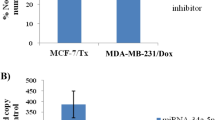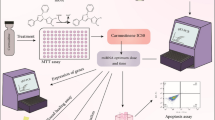Abstract
Objectives
Gemcitabine (Gem) is one of the most commonly used chemotherapeutic drugs in treating patients with pancreatic ductal adenocarcinoma (PDAC). Acquired drug resistance against Gem presents a major clinical challenge in the chemotherapy of PDAC. It has been shown that miRNA-3662 is lowly expressed and implicated with quantities of biological processes in cancer. However, whether miRNA-3662 regulates chemoresistance in PDAC remains largely unknown.
Materials and methods
The level of miRNA-3662 in PDAC tissues was determined by real-time qPCR (RT-qPCR). Functional experiments were used to investigate the biological role of miRNA-3662 on Gem resistance of PDAC in vitro and in vivo. Fluorescence in situ hybridization (FISH), RT-qPCR, western blotting, bioinformatics analysis and luciferase reporter assay were employed to determine the precise regulation mechanisms.
Results
In this study, it was investigated that miRNA-3662 was down-regulated in PDAC clinical samples as well as cell lines. Functional assays revealed that miRNA-3662 was sufficient to inhibit Gem resistance in PDAC cells both in vitro and in vivo. Mechanistically, hypoxia-inducible factor 1ɑ (HIF-1ɑ) was one of the transcriptional target of miRNA-3662 and was up-regulated in PDAC samples. Importantly, genetic promoting of HIF-1ɑ largely compromised miR-3662-mediated chemosensitive effects. In addition, miR-3662 could impair the aerobic glycolysis in PDAC cells.
Conclusions
This study sheds light on miRNA-3662 inhibits PDAC cell chemoresistance and aerobic glycolysis through a negative feedback loop with HIF-1ɑ. Therefore, the co-delivery of miR-3662 and Gem could be served as a promising therapeutic regimen for PDAC patients.








Similar content being viewed by others
Abbreviations
- Gem:
-
Gemcitabine
- PDAC:
-
Pancreatic cancer
- FISH:
-
Fluorescence in situ hybridization
- RT-qPCR:
-
Real-time qPCR
- HIF-1ɑ:
-
Hypoxia-inducible factor 1ɑ
- miRNAs:
-
MicroRNAs
- dCK:
-
Deoxycytidine kinase
- IHC:
-
Immunohistochemical
- Tunel:
-
Terminal deoxyribonucleotidyl transferase-mediated dUTP nick end labeling
References
Mizrahi JD, Surana R, Valle JW et al (2020) Pancreatic cancer. Lancet 395(10242):2008–2020
Yang J, Ren B, Yang G et al (2020) The enhancement of glycolysis regulates pancreatic cancer metastasis. Cell Mol Life Sci 77(2):305–321
Paternoster S, Falasca M (2020) The intricate relationship between diabetes, obesity and pancreatic cancer. Biochim Biophys Acta Rev Cancer 1873(1):188326
Jiang H, Liu X, Knolhoff BL et al (2020) Development of resistance to FAK inhibition in pancreatic cancer is linked to stromal depletion. Gut 69(1):122–132
Yang Z, Zhao N, Cui J et al (2020) Exosomes derived from cancer stem cells of gemcitabine-resistant pancreatic cancer cells enhance drug resistance by delivering miR-210. Cell Oncol (Dordr) 43(1):123–136
Riera Leal A, Ortiz-Lazareno PDAC, Jave-Suárez LF et al (2020) 17beta-estradiol-induced mitochondrial dysfunction and Warburg effect in cervical cancer cells allow cell survival under metabolic stress. Int J Oncol 56(1):33–46
Cassim S, Vučetić M, Ždralević M et al (2020) Warburg and beyond: the power of Mitochondrial metabolism to collaborate or replace fermentative glycolysis in cancer. Cancers (Basel) 12(5):1119
Wang XX, Yin GQ, Zhang ZH et al (2020) TWIST1 transcriptionally regulates glycolytic genes to promote the Warburg metabolism in pancreatic cancer. Exp Cell Res 386(1):111713
Dai W, Meng X, Mo S et al (2020) FOXE1 represses cell proliferation andWarburg effect by inhibiting HK2 in colorectal cancer. Cell Commun Signal 18(1):7
Liang L, Chen Y, Yu Y et al (2020) SLC25A18 has prognostic value in colorectal cancer and represses Warburg effect and cell proliferation via Wnt signaling. Am J Cancer Res 10(5):1548–1567
Ren X, Su C (2020) Sphingosine kinase 1 contributes to doxorubicin resistance and glycolysis in osteosarcoma. Mol Med Rep 22(3):2183–2190
Zhang Z, Tan X, Luo J et al (2020) The miR-30a-5p/CLCF1 axis regulates sorafenib resistance and aerobic glycolysis in hepatocellular carcinoma. Cell Death 11(10):902
Hansen TB, Kjems J, Damgarrd CK et al (2013) Circular RNA and miR-7 in cancer. Cancer Res 73(18):5609–5612
Mohammadi Torbati P, Asadi F, Fard-Esfahani P et al (2019) Circulating miR-20a and miR-26a as biomarkers in prostate cancer. Asian Pac J Cancer Prev 20(5):1453–1456
Zhang H, Deng T, Liu R et al (2020) CAF secreted miR-522 suppresses ferroptosis and promotes acquired chemo-resistance in gastric cancer. Mol Cancer 19(1):43
He M, Jin Q, Chen C et al (2019) The miR-186-3p/EREG axis orchestrates tamoxifen resistance and aerobic glycolysis in breast cancer cells. Oncogene 38(28):5551–5565
Zhang Z, Tan X, Luo J et al (2020) The miR-30a-5p/CLCF1 axis regulates sorafenib resistance and aerobic glycolysis in hepatocellular carcinoma. Cell Death Dis 11(10):902
Hu Z, Cai M, Zhang Y et al (2020) miR-29c-3p inhibits autophagy and cisplatin resistance in ovarian cancer by regulating FOXP1/ATG14 pathway. Cell Cycle 19(2):193–206
Powrózek T, Kuźnar-Kamińska B, Dziedzic M et al (2017) The diagnostic role of plasma circulating precursors of miRNA-944 and miRNA-3662 for non-small cell lung cancer detection. Pathol Res Pract 213(11):1384–1387
Cheng S, Huang Y, Lou C et al (2020) MiR-3662 suppresses cell growth, invasion and glucose metabolism by targeting HK2 in hepatocellular carcinoma cells. Neoplasma 67(4):773–781
Yasui K, Izumida M, Nakagawa T et al (2018) MicroRNA-3662 expression correlates with antiviral drug resistance in adult T-cell leukemia/lymphoma cells. Biochem Biophys Res Commun 501(4):833–837
Bullock MD, Pickard KM, Nielsen BS et al (2013) Pleiotropic actions of miR-21 highlight the critical role of deregulated stromal microRNAs during colorectal cancer progression. Cell Death Dis 4(6):e684
Zhang JG, Zhou HM, Zhang X et al (2020) Hypoxic induction of vasculogeni- mimicry in hepatocellular carcinoma: role of HIF-1 alpha, RhoA/ROCK and Rac1/PAK signaling. BMC Cancer 20(1):32
Maity G, Ghosh A, Gupta V et al (2019) CYR61/CCN1 regulates dCK and CTGF and causes Gemcitabine-resistant phenotype in pancreatic Ductal Adenocarcinoma. Mol Cancer Ther 18(4):788–800
Sierzega M, Pach R, Kulig P et al (2017) Prognostic implications of expression profiling for Gemcitabine-related genes (hENT1, dCK, RRM1, RRM2) in patients with resectable pancreatic Adenocarcinoma receiving adjuvant Chemotherapy. Pancreas 46(5):684–689
Chen Z, Wang Z, Guo W et al (2015) TRIM35 Interacts with pyruvate kinase isoform M2 to suppress the Warburg effect and tumorigenicity in hepatocellular carcinoma. Oncogene 34(30):3946–3956
Kanamori A, Matsubara D, Saitoh Y et al (2020) Mint3 depletion restricts tumor malignancy of pancreatic cancer cells by decreasing SKP2 expression via HIF-1. Oncogene 39(39):6218–6230
Katagiri T, Kobayashi M, Yoshimura M et al (2018) HIF-1 maintains a functional relationship between pancreatic cancer cells and stromal fibroblasts by upregulating expression and secretion of Sonic hedgehog. Oncotarget 9(12):10525–10535
Puisségur MP, Mazure NM, Bertero T et al (2011) MiR-210 is overexpressed in late stages of lung cancer and mediates mitochondrial alterations associated with modulation of HIF-1 activity. Cell Death Differ 18(3):465–478
Seo J, Jeong DW, Park JW et al (2020) Fatty-acid-induced FABP5/HIF-1 reprograms lipid metabolism and enhances the proliferation of liver cancer cells. Commun Biol 3(1):638
Liu C, Xing H, Guo C et al (2019) MiR-124 reversed the doxorubicin resistance of breast cancer stem cells through STAT3/HIF-1 signaling pathways. Cell Cycle 18(18):2215–2227
Fulda S, Debatin KM (2007) HIF-1-regulated glucose metabolism: a key to apoptosis resistance? Cell Cycle 6(7):790–792
Chen Y, Huang F, Deng L et al (2019) HIF-1alpha-derived cell-penetrating peptides inhibit ERK-dependent activation of HIF-1 and trigger apoptosis of cancer cells under hypoxia. Cell Mol Life Sci 76(4):809–825
Silakit R, Kitirat Y, Thongchot S et al (2018) Potential role of HIF-1-responsive microRNA210/HIF3 axis on gemcitabine resistance in cholangiocarcinoma cells. PLoS ne 13(6):e0199827
Acknowledgements
We thank the Scientific Research Fund of Hunan Provincial Education Department (No. 20A213 and No. 19B236) and Natural Science Foundation of Hunan Province (No. 2020JJ5221) for financial support.
Author information
Authors and Affiliations
Contributions
(I) Conception and design: all the authors; (II) administrative support: An Liu and Yonggui Zhou; (III) provision of study materials or patients: Jia Xu; (IV) collection and assembly of data: Tian Zhao and Xu Tang; (V) data analysis and interpretation: Binbin Zhou; (VI) manuscript writing: all the authors; (VII) final approval of manuscript: all the authors.
Corresponding authors
Ethics declarations
Conflict of interest
The author declares that he has no competing interests.
Additional information
Publisher's Note
Springer Nature remains neutral with regard to jurisdictional claims in published maps and institutional affiliations.
Rights and permissions
About this article
Cite this article
Liu, A., Zhou, Y., Zhao, T. et al. MiRNA-3662 reverses the gemcitabine resistance in pancreatic cancer through regulating the tumor metabolism. Cancer Chemother Pharmacol 88, 343–357 (2021). https://doi.org/10.1007/s00280-021-04289-z
Received:
Accepted:
Published:
Issue Date:
DOI: https://doi.org/10.1007/s00280-021-04289-z




